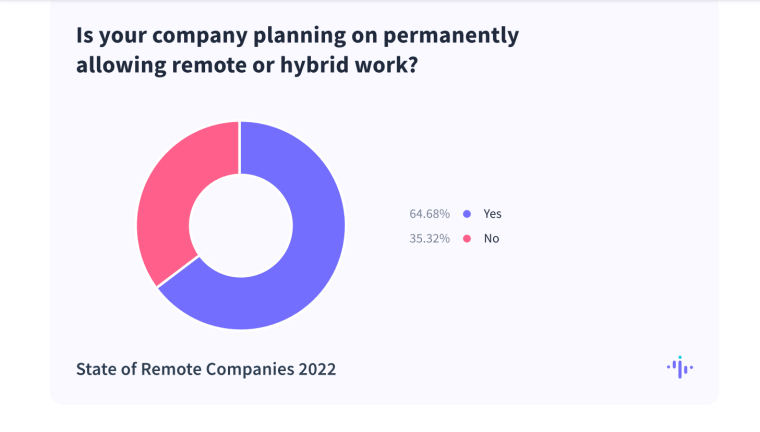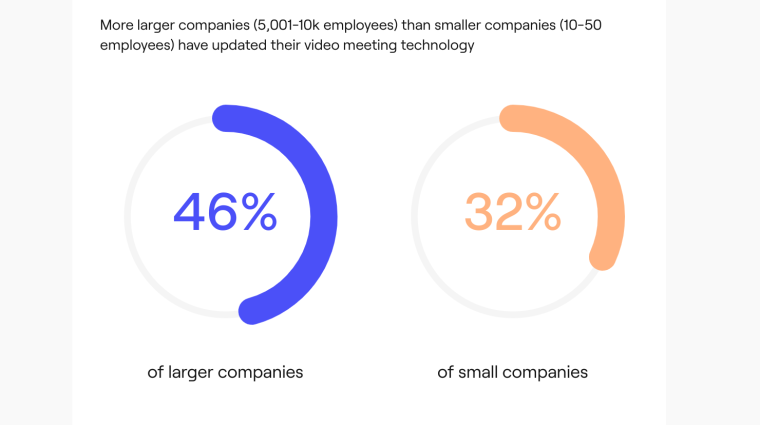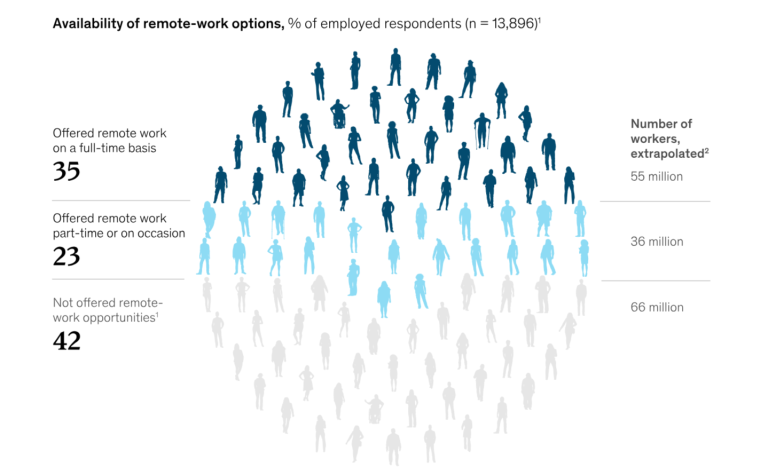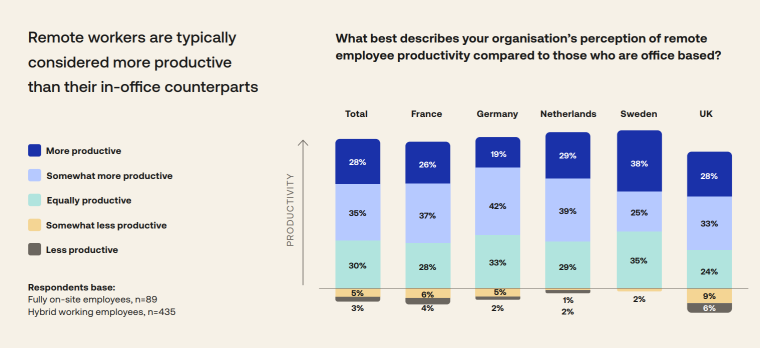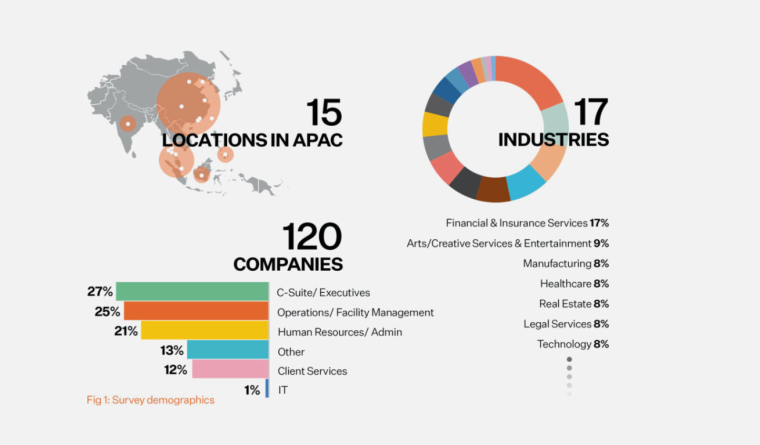Remote work continues to shape the way we work, offering new opportunities for flexibility and productivity.
Whether you’re an employer, employee, or independent worker, understanding the complexities of this evolving trend is crucial.
Insights on this phenomenon can be found in various reports and sources across the web. However, making sense of it all can be time-consuming. To save you the trouble, we’ve put together over 100 remote work statistics, covering trends, effectiveness, and more.
The transition to remote and hybrid work models has accelerated significantly, reshaping not only where we work but also how we work. Here are some pivotal insights from recent statistics: Hybrid workplaces are here to stay, with remote workers set to make up 32% of all employees worldwide by 2024, according to Gartner. The rise of hybrid workplaces signifies a long-term change in the way organizations operate and highlights the increasing acceptance and adoption of remote work practices globally. A 2022 report by Insightful revealed that 38% of companies that adopted remote work had between 51 and 200 employees. Companies with less than 50 employees were the next most likely to work remotely (32.4%). Overall, the highest jump in the adoption of remote work was seen in enterprise companies (over 500 employees) such as Microsoft, Google, and others, where adoption increased from 2.2% in 2019 to 10.6% in 2022. The same report found that 56% of companies shifted to remote or hybrid work because of COVID-19. Even as restrictions have eased globally, 68% of companies now allow employees to continue working in a hybrid or remote environment. At least 71% will allow remote work at least some of the time. Furthermore, 52% of the companies surveyed said the transition to remote work was smooth. Of the 43% that said their transition wasn’t smooth, the top 5 key challenges cited were: According to Statista, Gen Z was the least likely to be as productive working virtually, with only 23% stating they were just as productive remotely as they were when working in an office. Baby Boomers were the most confident in their remote work, with 65% claiming no change in productivity when working from home. Millennials, however, were divided, with half of all respondents reporting no changes in productivity when working remotely. As of May 2023, 12% of full-time employees were working fully remotely, while 29% were hybrid and 59% in-office. This is according to data from WFH Research, which tracks remote work trends. A hybrid work schedule remains the most common setup for workers allowed to work from home. According to FlexJobs, some companies that have embraced permanent remote work in 2023 include: Researchers at Stanford, Harvard, and other institutions analyzed over 50 million job postings in February 2023 and found that postings explicitly mentioning remote work were up 12.2%. This represents a fourfold increase since before the pandemic, suggesting that hybrid and remote work is here to stay. As of 2023, companies have been working to formalize their work-from-home policies, with many trying to persuade employees to come back to the office. While remote work has its benefits, more CEOs and executives have started to question the merits of remote work. For example, Marc Benioff, CEO of Salesforce, (where employees were told they could work remotely permanently) expressed concern over lower productivity levels among some employees. User levels of video conferencing apps such as Zoom and Google Meet settled down in 2022 but still saw impressive download numbers. In 2022: While daily active users fell slightly from peak 2020 levels and mostly leveled off since 2022, activity levels are still above where they were in 2019. This suggests remote work may be the new normal for a large percentage of the workforce. In Q2 2022, Microsoft accounted for almost 40% of the global unified communications and collaboration market. Collaboration software such as Teams became a vital part of remote and hybrid workforce environments, allowing teams to work together more effectively. As of 2022, there were an estimated 270 million daily users of Microsoft Teams worldwide. That’s a significant jump from 2017, when there were about two million users on the platform. According to Apptopia, the number of reviews with the keyword “remote” in them on top job apps increased by 900% between 2019 and 2022. As the demand for remote work grows, an increasing number of jobseeker reviews are requesting app publishers make it easier for them to search for open jobs by levels of remoteness (partially remote, local but remote, fully remote, etc). According to Statista, there were 23,500 co-working spaces with 4.3 million members in 2022, triple the pre-pandemic level. Globally, there were around 13,800 co-working spaces in 2017, with just over 1.1 million members. Coworking refers to an open working environment, which allows for several unrelated companies or location-independent workers to share a space and work side by side. In 2022, endpoint security software and virtual private networks (VPNs) were the most used technologies by companies to secure work-from-home and hybrid work environments. Because remote work has created opportunities for new security threats and vulnerabilities, vendors like Cisco, Palo Alto Networks, and Fortinet have become essential to cybersecurity. According to a report by McKinsey, 87% of employees would take up the chance to work flexibly. This dynamic is widespread across demographics, occupations, and geographies. Job seekers value having autonomy over where and when they work. In fact, flexibility was the third most popular reason surveyed employees had for job hunting. The same report found that 55% of 18-to 34-year-olds offered the option to work fully remotely said mental-health issues impacted their ability to perform effectively. Only 17% of people aged 55 to 64 said the same. A report by OwlLabs revealed that 29% of workers switched jobs between 2021 and 2022. According to OwlLabs, twice as many remote workers switched jobs than in-office workers. Among those who changed jobs, the top reasons included: Buffer surveyed 3,000 remote workers from around the world for its State of Remote Work 2023 report and found that: The same report found that 82% of remote workers surveyed worked from home. This was significantly higher compared to 2022 when 59% of survey takers said they were working from home. When asked which room they used when working from home, 37% stated they used a dedicated office space. 20% worked from their living rooms while 21% worked from their bedrooms. According to Buffer’s findings, 75% of remote workers spent 1-10 hours of the work week in meetings. Meanwhile, 52% worked one to five hours, while 23% spent six to 10 hours a week in meetings. Additionally, video calls were cited as the most frequent way remote teams conducted meetings. In a 2022 report on remote work, Ivanti sought insights from thousands of professionals across the world and found that: Additionally, 49% of survey respondents said they had been negatively affected by remote work in some way. Among the top concerns with remote work were: Excluding job titles and other factors, employees who worked remotely made 23.7% more than non-remote employees in 2021. Payscale found that employees who telecommuted 100% of the time earned more compensation than employees who did not work remotely at all. According to FlexJobs, employees can save $6,000 working at home half the time in a hybrid role and up to $12,000 per year by working remotely full-time. While the total amount varies based on location, salary, and other factors, remote workers stand to save on commuting costs, clothing, and eating out. According to the Ivanti report, male respondents working in IT cited the following as the main benefits of remote working: While female IT professionals mentioned the following: The same report revealed that women in IT have had the hardest time adjusting to remote work. 70% of female respondents reported experiencing negative effects due to remote work, compared to only 30% of male respondents. It was also revealed that 72% of respondents working remotely in IT lost team members due to a high workload. With workplaces navigating new technology, the demands on IT professionals are increasing. IT staff are often expected to be available round the clock to assist other workers. As of 2022, around 92 million workers were offered flexible work in the US. 41% of small companies (10-50 employees) in the US required employees to return to the office compared to 27% of enterprises (10K+ employees). 27.42% of employers surveyed by Insightful said measuring productivity was the biggest change brought on by remote or hybrid work. As remote work changes how teams work, the greatest challenge for employers remains how to measure productivity. 49.5% of companies did not encourage asynchronous communication. Meanwhile, 51% of companies encouraged asynchronous communication for greater flexibility within teams, almost half did not. 38% of companies surveyed by Insightful felt that employees are less productive in a remote or hybrid environment. In addition, 63.91% of all the companies surveyed stated they didn’t have the right tools such as devices, equipment, resources, and applications to manage employee productivity. Remote work can lead to annual savings of up to $11,000 for each half-time remote worker. Nearly 60% of employers identify cost savings as a major benefit of telecommuting. Global Workplace Analytics estimates that companies can save over $700 billion annually which equates to more than $11,000 per employee per year. Real-life examples of savings from remote work include: In a 2022 report by McKinsey, 58% of Americans reported having the opportunity to work from home at least one day a week. The report further found that: This was for work in all kinds of jobs, in every part of the country and sector of the economy, including traditionally blue and white-collar professions. The same report found that 41% of employed respondents did not have the option to work remotely. This was mainly because not all work can be done remotely or because employers simply demand on-site work. Additionally, 87% of workers offered some remote work took advantage of it. Of the workers offered work-from-home options, the majority spent an average of three days a week working from home. According to McKinsey, 61% of men were offered remote working opportunities. This is compared to only 52% of women, highlighting a slight disparity in work-from-home opportunities across gender lines. 17% of those earning $25,000 to $74,999 per year who were offered remote work didn’t take it. This is opposed to only 10% of those earning over $75,000 a year. Overall, those earning higher incomes were more likely to take on work-from-home opportunities. 19% of 55 to 64-year-olds offered remote work didn’t take advantage of it. This is compared to around 13% of younger workers. Generally, those who are offered remote options and don’t take them tend to be older. At every income level, younger workers were more likely than older workers to report having and taking up work-from-home opportunities. Employees choosing hybrid work in the US went up by 16%. Meanwhile, interest in office work dropped by 24%. More employees are opting to divide their time between the office and their homes. 66% of workers would start looking for a job immediately if the option to work from home was no longer available. Among those surveyed, 39% would simply quit. According to OwlLabs, 62% of workers felt more productive working remotely This is compared to only 11% who felt less productive. Millennials felt the most productive while working from home (66%), while Boomers felt the least (46%) productive. As of 2022, around 25% of Canadians worked remotely. This is down from around five million Canadian employees in March 2021. A 2022 study of over 6,604 Canadians aged 18 and above conducted between March and April found that almost 50% of employed Canadians worked from home for at least some days. In addition, remote work was more common among: Specifically, those engaged in remote work post-pandemic were: It was further revealed that between late 2020 and early 2022, that those working remotely were more likely to report positive experiences, and less likely to report negative ones. The number of employees that preferred working from home increased from 64% in December 2020 to 78% in April 2022. Furthermore, those who hoped employers would continue to allow them to work from home increased from 71% to 76% within the same period. Finally, over 10% of Canadians moved to a different community because they had the option to work remotely. The study found that moving was more common: In comparison, a 2022 study of over 500 Canadian hiring decision-makers revealed that over 76% of Canadian businesses that allowed remote work since the start of the COVID-19 pandemic stated they would continue to allow their employees to work remotely. The most common reason cited was to attract and retain employees. 49% of these employers state that remote work had a positive impact on their company as a whole, while only 15% said it had a negative impact. The remainder said remote work had no impact at all. The study also reported that 46% of employers believed remote work had not impacted employee productivity. Additionally, 22% reported that employees became more productive because of remote work, while 32% said employees became less productive. Remote workers in the EU may work from home up to a maximum of 49% after July 1, 2023, without affecting their social security position. Across the EU, notably in the Netherlands, the ability to work from home is now considered a legal right. Depending on the combination of the country of residence and country of employment, employees can continue to work from home up to a maximum of 49% via an ‘opting-in’ arrangement, without this affecting their social security position. In 2022, 57% of enterprises with 10 or more employees or self-employed persons were technologically ready to offer remote work. Eurostat measured the technological readiness of enterprises according to three types of remote access (email systems, documents, and business applications or software) offered to employees and found that: In 2022, in the EU, 50% of enterprises with 10 or more employees or self-employed persons conducted remote meetings. Across the EU, there was considerable variation in the number of businesses that conducted remote meetings. Remote meetings were most common in the following countries: In contrast, remote meetings were least common in the following countries: Between September and October 2022, Okta surveyed 524 digital workplace decision-makers from the UK, Germany, France, the Netherlands, and Sweden about existing and future hybrid work plans. In the UK, online searches for remote work hit a five-year high in January 2023. The number of searches for work-from-home jobs jumped by 123%. Searches for ‘hybrid roles’ hit a new high in the UK, increasing by 614% from December 2022. The volume of searches for ‘work from home jobs’ is estimated to be 72,000 per month in the UK. In fact, as of 4 July 2023, there are currently over 30,280 work-from-home jobs listed on Indeed. The UK’s technology sector has the largest proportion of remote working jobs, accounting for 30% of the UK’s advertised remote vacancies. The UK tech industry is increasingly embracing remote and hybrid working, according to a study by Cord. A 2023 remote working survey conducted by MMoser Associates evaluated the experiences of 120 clients in 15 major hubs across the Asia Pacific and found that: According to Bloomberg, a 2022 survey of 2,170 business leaders in 13 Asia-Pacific countries, found that businesses wanted their employees in the office at least some of the time. Only 7% of managers expected staff to work remotely all of the time. This is compared to just under 5% pre-pandemic. Attracting talent was cited by 42% of respondents as the second most important reason for adopting a hybrid working model. The same survey revealed that 50% of companies in Asia expected their staff to work in the office full-time before the pandemic. In 2022, that number fell below 13%. Attitudes towards remote work continue to vary across the Asia Pacific region. Singapore, Australia, and New Zealand have embraced flexible working and will continue to do so over the next 3 to 5 years. China, Japan, and India were the least receptive to flexible and fully remote work. It was also found that around 34% of workers expected to spend more than 75% of their time in the office. This is down from around 79% of the time pre-pandemic. A 2022 report by IDC revealed that over 56% of the employees in Asia Pacific (excluding Japan) wanted the flexibility to work both in the office and remotely, even beyond the pandemic. Additionally, IDC data showed that more than 70% of employees said their productivity was higher or at least at the same level compared to before the pandemic. Indeed and Glassdoor’s Hiring and Workplace Trends Report 2023 revealed that software development job posts were the most popular for remote work across markets. The same report found that in the US, Canada, Germany, France, and the UK, ‘software development’ was the job title most often associated with remote work. A majority of people employed in computer and mathematical occupations report having remote work options. In fact, 77% report being willing to work fully remotely. In sectors like the computer industry, business operations, and finance, as well as in arts, design, media, and entertainment, the share of employees who have the possibility to work remotely full-time exceeds 50%. In a study by Insightful, architecture, and healthcare were the most common industries for remote companies in 2022. At 18.7% and 16.9% respectively, architecture and healthcare were the top two industries where remote work was widely adopted. Other key industries included: By the end of 2023, 39% of global knowledge workers will work hybrid, up from 37% in 2022, according to Gartner. Although many employees returned to the office in 2022, hybrid work became a prominent feature in workplaces across the globe. In 2023 and beyond, hybrid work set-ups are set to increase as employers respond to the call to prioritize flexibility. Hubspot surveyed over 5,000 full-time remote, in-office, and hybrid/flex workers from companies across 10 markets and found that 40% of hybrid workers chose to go into the office to communicate more efficiently with colleagues. Additionally, 43% chose to go to the office to connect with colleagues, further confirming the importance of connection, even in remote settings. In 2022, Cisco surveyed over 28,000 full-time employees across 27 markets and found that hybrid work improved productivity, well-being, work-life balance, relationships, and even personal confidence across different generations, gender, and seniority. In addition, the report uncovered the following key insights about hybrid work: Hybrid work varies significantly by country, with employers in Japan focused more on employees returning to the office full-time compared with other employers around the globe. Only 29% of Japan’s workforce in 2023 will be made up of fully remote and hybrid knowledge workers. Figures for countries where hybrid work is on the rise are significantly higher. For example: According to the World Bank, freelancers account for over 46% of the global workforce. That’s 1.6 billion freelancers out of a total global labor force of 3.43 billion. As of 2023, Payoneer reported that the top freelancing countries offering a favorable freelancer environment, high demand, supportive policies, and easy access to payment solutions were: Freelance rates vary across regions, with freelancers in North America leading with an average hourly rate of $44. In second and third place are Western Europe and South America, where freelancers make an average of $31 and $24 per hour, respectively. In Asia, Africa, and Central and Eastern Europe, freelancers made an average of $22 per hour. Upwork’s 2022 Freelance Forward survey revealed that 39% of the US workforce, or 60 million Americans, freelanced in the past year. The survey also uncovered the following key insights: According to Statista, 46% of Millennials worked as freelancers in 2022. This number was slightly lower for Gen Z at 43% and Gen X at 35%. The rise of influencer culture and content is drawing an increasingly higher number of younger people to freelancing. Global estimates suggest that there were around 35 million digital nomads in 2022. According to the WYSE Travel Confederation, Millennials and Gen Z accounted for around 70% of digital nomads. According to research by Ivanti, there were over 15.5 million digital nomads in the US in 2021. This represents a 222.92% increase from just 4.8 million digital nomads in 2018, making the US the country with the highest number of digital nomads. According to Statista, as of October 2022, the majority of countries that offered digital nomad visas were located in Europe. Over 25 countries offered digital nomad visas in 2022. As of 2023, over 50 countries now offer digital nomad visas. Most of these countries are located in Europe, Latin America, and the Caribbean with more countries joining the trend. Digital nomads were primarily self-employed as of 2022. More than 50% were business owners and around 35% were freelancers or gig workers. There were only a handful of countries that offered digital nomad visas for more than a year in 2022. The vast majority granted visas for a year or less. Thailand, however, is the exception, with its 10-year visa. The requirements for this visa include earnings of $80,000 in the previous two years or a bank balance of $1 million. The average visa fee was around $500 in 2022. However, considerable variations existed between countries. Generally, the Caribbean islands had the most expensive fees, with Barbados and Anguilla charging nomads $2,000. In 2022, most countries had a minimum earnings requirement of around $3,000 a month. The requirements for some countries were substantially higher. For example, the Cayman Islands and Belize asked for $100,000 and $80,000, respectively. There were also a number of countries that had no earnings requirements. As a result of remote work, office values in the US fell by 45% in 2020, and are likely to remain 39% below pre-pandemic levels for the foreseeable future. In addition to reducing property values in American cities by $453 billion, this would eliminate a vital source of revenue for municipalities. For example, in New York City, property taxes are the single largest source of public funds, supplying one-third of the city’s tax revenue. Office buildings account for 20% of that amount. The declining market value of Manhattan’s major office districts alone cost the city $5.24 billion in revenue in 2022. According to Bloomberg, the remote-work gap continues to favor British cities, leaving post-industrial areas behind. Major cities like Manchester, Bristol, and London continue to see an increase in remote jobs, while the opportunities in post-industrial towns are declining. Manchester has the highest share of remote jobs at 29.3%. London, Leeds, and Cambridge are also among the best places for flexible work. However, remote-friendly job opportunities in post-industrial or tourism-oriented towns have fallen to less than 10%. In 2023, the projected gross volume of the gig economy is expected to reach $455 billion. The gig economy refers to the various digital platforms that enable freelancers to connect with potential clients for contracted work or short-term jobs. According to data from Upwork, companies will rely on remote freelancers even more in the future. In the next 6 months, 45% of companies plan to use more remote freelancers, and over the next 2 years, this will go up to 47% of companies. Technology companies are set to profit from hybrid work over the next six years. As businesses continue to adopt technological innovations to support hybrid work models, key cloud providers like Amazon Web Services, Microsoft Azure, and Google Cloud are set to play a major role in accelerating digital transformation. The collaboration software market revenue was valued at $19.5 billion in 2022 and is projected to increase to nearly $21 billion by 2025. Efficient remote and hybrid work environments are dependent on the right collaboration tools. As more companies shift to hybrid working models, revenue growth will be driven by the increasing demand and usage of collaboration tools. There will be some 41,975 coworking spaces worldwide by the end of 2024. As more companies embrace more flexible work options, co-working spaces are set to double by 2025. The global number of digital nomads is projected to hit 40 million in 2023 and 60 million by 2030. This will primarily be driven by the younger demographics increasing desire for freedom, flexibility, and location-independent work.Remote Work Statistics Highlights
Key Takeaways: Understanding Remote Work
The State of Remote Working Statistics
Trends in Telecommuting Statistics
The Effectiveness of Remote Work Stats
Employee Remote Work Data
Employer Remote Work Data
Remote Working Statistics by Country
North America Remote Work Statistics
US Telecommuting Stats
Canada Telecommuting Stats
Europe Remote Working Statistics
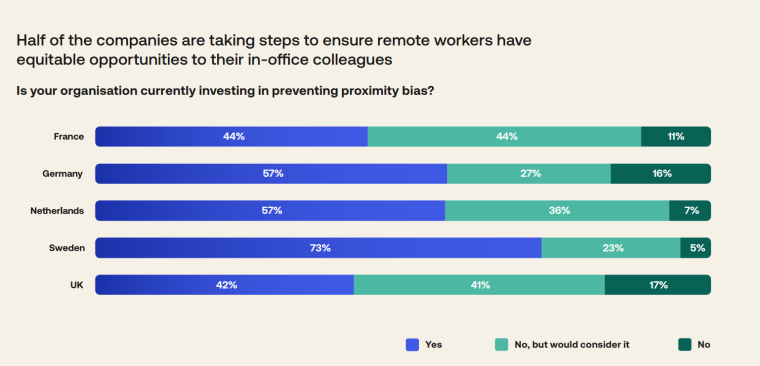
UK Telecommuting Stats
Asia Pacific Remote Working Statistics
Data on Types of Remote Jobs
Hybrid Work Statistics
Freelancing Statistics
Digital Nomading Statistics
The Future of Remote Working Statistics
FAQs
What percentage of the world is working remotely?
How effective is remote work?
Has remote work increased since COVID?
Why is remote working better?
Is remote working increasing or decreasing?
References
- Gartner
- Insightful: State of Work 2023
- Statista
- CBS News
- WFH Research
- FlexJobs
- WFH Map
- Business Insider
- Apptopia
- Statista
- Apptopia
- Statista
- Statista
- McKinsey
- OwlLabs: State of Remote Work 2022
- Buffer: State of Remote Work 2023
- Ivanti: 2022 Everywhere Work Report
- Payscale 2021 Remote Work Report
- FlexJobs
- Global Workplace Analytics
- Statista
- Future Skills Centre
- Global Newswire
- Eurostat
- Okta Hybrid Work 2023 Report
- HR News
- Cord
- MMoser Associates
- Bloomberg
- IDC
- Indeed and Glassdoor Hiring Trends Report 2023
- Gartner
- Hubspot 2023 Hybrid Report
- Cisco Hybrid Work Report
- World Bank
- World Bank
- Payoneer
- Upwork
- WYSE Travel Confederation
- Statista
- Business Insider
- New York Magazine
- Bloomberg
- Statista
- Upwork
- Statista


